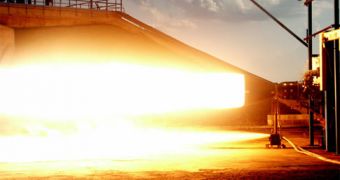Space Exploration Technologies Corporation, commonly known as SpaceX, represents a space-transportation startup company founded in 2002, which has the goal to improve the cost and reliability of space travel. The Falcon 9 represents a stage of development that uses a multi-engine rocket in order to create a heavy-lift reusable launch vehicle. On January 18, SpaceX tested, for the first time, two of the nine Merlin 1C engines which the Falcon 9 rocket will use when going into production.
In a press statement, Elon Musk founder and CEO of SpaceX said that this represents a very important step for the corporation since it is the first test when engineers successfully operate two engines at the same time. When completed, the nine Merlin engines equipping the the Falcon 9 rocket would be able to produce a total power output equivalent to half of million kilograms of thrust, about four times more than the thrust generated by the engines of a Boeing 747 airplane in full power.
However, putting nine rocket engines together is not as simple as one might think, as they require additional pluming, faster fuel and oxidizer drain rates and faster flow rates through the drain pipes. Although the first test of the Merlin 1C engine took place less than three months ago, SpaceX claims to have had no obvious problems with the transition from the single rocket design to the multiple rocket.
Musk argues that SpaceX is in no hurry and will try to take things slowly, meaning that they will continue testing their design by slowly increasing the number of engines on the testing rig in order to perfect simultaneous firing techniques. In the month of February, a test is scheduled, using three engines at the same time, after which they will continue adding rocket engines to the tests coming in the following months.
SpaceX Falcon 9 rocket design is thought to become an alternative for medium and heavy space lifting cargo carrier, capable of putting payloads having weights up to 27,500 kilograms into Earth's lower orbit and loads up to 12 tonnes in geostationary orbits. At the same time, SpaceX is developing a small payload carrier, namely Falcon 1, which is powered by a single Merlin 1C rocket engine, to be tested in the next months.
Similar to the solid rocket boosters used by the U.S. space shuttle, both the Falcon 1 and Falcon 9 rockets are intended to be recyclable in order to reduce the costs related to rocket manufacturing process. Elon Musk, SpaceX CEO, says that the company is also targeting the people carrying segment with the development of the Dragon space capsule that will be able to support a crew of seven when completed, and is being specially designed to have International Space Station docking capabilities. It is predicted that the capsule will be ready for operation by the year 2009 in order to serve as a alternative to the space shuttle which will go out of service in 2010, after more than three decades of activity.

 14 DAY TRIAL //
14 DAY TRIAL //